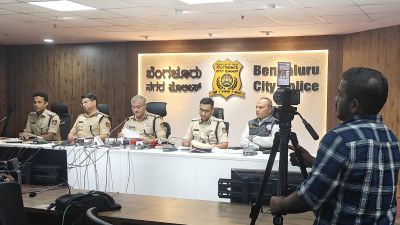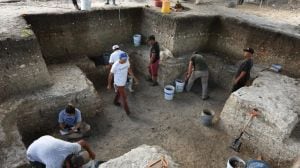Raj nostalgia
RAJ KAPOOR Raj's boisterous, prankish nature made him popular at Antonio de Silva School at Dadar, Bombay. As a student, he excelled more...

RAJ KAPOOR
Raj’s boisterous, prankish nature made him popular at Antonio de Silva School at Dadar, Bombay. As a student, he excelled more in elocution than in studies. Raj’s second love was eating. His fondness for good food led to a rotund figure. In the early 40s when Nargis did not know him, the plumpish, chubby Raj once caught her eyes while she was getting into a car with her mother, and Nargis shouted excitedly, "Mummy, look. What a fat boy! He looks like a baby elephant!" Mother Jaddanbai reprimanded her , "Keep quiet! Did you know he is Prithviraj’s son?"
In 1937 when he was a student at St Xavier’s school in Calcutta, Raj’s attempts to play a minor role in the annual day gathering failed miserably. And he was told by his teacher in all seriousness, "You will never be an actor." But despite these incidents, Raj was always inspired by his father. As he recalls, "I was hardly eight years old at that time. Papaji was present at that function and I was struck with stage-fright, but he patted me and pushed me on that stage."
Another interesting incident was when Raj was supposed to play a servant’s role in a periodical play. At the 11th hour, he rushed to his father in the audience and said, I think, I will look nice if I put on a moustache". Prithviraj replied, "O K, but see that you look like a servant and not a king. Be careful about the type of moustaches you wear." Raj argued. Prithviraj rose from his seat with his inevitable broad smile and said: "Oh, then I am here to learn from you!". The gathering burst into laughter.
Despite this affinity to acting, Raj hadn’t decided about his career till he was 17. Prithviraj gave his consent at once and entrusted Raj to director Kidar Sharma for grooming. Raj started right at the bottom as a clapper-boy. After three years of hard grooming under Kidar Sharma, he shifted to Bombay Talkies, with his father’s recommendation, to Devika Rani who was then controller of production. He joined as one of the junior assistants to director Amiya Chakrabarty. And here he started his acting career with a peon’s role in BT’s Hamari Baat. His name appeared last in the credit-list of the picture. He was still at the lowest rung. He left Bombay Talkies in sheer frustration and, after some time, joined Prithvi Theater. Here he got the scope to develop his talents. He was the art-director and special-effects expert for their maiden drama Shakuntala. But in Deewar, his hilarious caricature of a domestic servant, he became popular as a comedian.
By now he had slimmed down considerably and his father’s good looks reflected on his face. His success on stage attracted the attention of Kidar Sharma who gave him his first major film role as the hero of Neel Kamal. Though not a hit, it gave Raj the break that had eluded him till now. Earlier, he had appeared as Narad in Prabkhar Picture’s Valmiki with Prithviraj in the title-role. In one of his earlier films, Radha Krishna, Raj was cast as Krishna opposite Madhubala. After Neel Kamal, director Mohan Sinha cast him as the hero in his comedy Dil Ki Rani. He also played an important role in Gajanan Jagirdar’s Jail Yatra.
But Raj yearned to do something more spectacular than merely acting romantic roles of the slapstick kind. In his usual carefree, audacious way, he mustered enough courage to produce his own films. But well-meaning friends warned him about the inevitable pitfalls of film production. Undeterred, Raj put his production plan into practice. As a newcomer to the field it was difficult to secure finance but Raj staked all his prestige and earnings into R K Films and with unstinted co-operation of his colleagues and co workers, he produced his first film Aag in 1948. The film was talked about before the release as well as this was the first time three popular heroines — Nargis, Nigar, and Kamini Kaushal were together in one film.
With himself in a memorable role of his career and with new comer Premnath making a welcome screen appearance, Aag created waves all over. In story-value directorial treatment, shot composition and music, Aag was far ahead of the films produced in that era. With his youthful team, Raj Kapoor established the trade-name R K Films as a hall-mark of quality pictures.
He consolidated his position as a producer-director-actor with Barsaat, a roaring box-office hit which is reported to have collected nearly a crore of rupees. Due to its delightfully catchy music and enjoyable romance, Barsaat set a new trend. The popularity of Raj-Nargis romantic pair made them the idols of film-going millions. Barsaat also gave two sensational stars in Nimmi and Premnath. Having earned sufficient money, Raj now concentrated on quality themes and gave Awara, a touching theme based on the problem of juvenile delinquency. Written by K A Abbas, Awara proved another triumph of Raj-Nargis pair and R K Films.
The stories of his pictures tell the story of Raj Kapoor. It was with deep insight and artistic acumen that he selected the theme of Jagte Raho. He was the first Indian producer who got the coveted Grand Prix Award in the International Festival at Kalove Vary.
Jis Desh Me Ganga Behti Hai got a certificate of merit from the Government of India and he was called the best actor for his outstanding performance by Filmfare. Sangam the next important film of his career, a lavish production, widened the scope and dimension of the Indian film in the true cinematic sense. He no longer stuck to the tradition and storylines. The next film was Mera Naam Joker. One of the boldest films of its time, it showed his ability to experiment and to break the mould time and again. After Kal Aaj Aur Kal, produced by Raj and directed by his son Randhir Kapoor, came Bobby, a teenage- romance which was a run away hit with the youngsters. After Bobby, Raj Kapoor’s next production was Dharam Karam directed by Randhir Kapoor. This movie has technical flourish and is done with a romantic gusto.
Raj Kapoor’s Filmography As Actor
* 1935 : Inquilab (as a child Artist)
* 1943 : Hamari Baat, Gauri
* 1946 : Valmiki
* 1947 : Chithod Vijay, Dil Ki Raani, Jail Yaatra, Neel Kamal
* 1948 : Amar Prem, Gopinath
* 1949 : Andaz, Parivartan, Sunehre Din
* 1950 : Banwra, Banwre Nain,Dastaan, Jaan Pehchan, Pyaar, Sargam
* 1952 : Ambar, Anhonee, Aashiana, Bewafa
* 1953 : Dhoon,Paapi
* 1956 : Chori Chori
* 1958 : Sharda,Parvarish,Phir Subah Hogi
* 1959 : Anari (Best Actor, Filmfare),Char Dil Char Raahein, DoUstad, Kanhaiya, Main Nashe Me Hoon
* 1960 : Chhalia, Shriman Satyavadi
* 1961 : Nazraana
* 1962 : Aashiq
* 1963 : Dil Hi To Hai, Ek Dil Sau Afsane
* 1964 : Dulha Dulhan
* 1966 :Teesri Kasam
* 1967 : Around The World,Diwana o 1968 : Sapnon Ka Saudgar
* 1973 : Mera Desh Mera Dharam
* 1975 : Do Jasoos
* 1976 : Khaan Dost
* 1977 : Chandi Sona
* 1978 : Naukri
* 1981 : Abdullah, Naseeb,Vakil Baboo
* 1982 : Gopichand Jasoos, Chor Mandli
As Actor, Producer & Director (also Screenplay Co-writer)
* 1948 : Aag
* 1949 : Barsaat As Actor, Producer & Director
* 1951 : Awara
* 1955 : Shri 420
As Actor& Producer
* 1953 : Aah
* 1954 : Boot Polish
* 1956 : Jagte Raho
* 1960 : Jis Desh Me Ganga Behti Hai (Best Actor, Filmfare)
* 1972 : Kal, Aaj Aur Kal
* 1975 : Dharam Karam
As Producer
* 1957 : Ab Dilli Dur Nahin
* 1981 : Biwi O Biwi
As Director, Story Writer & Editor
* 1985 : Ram Teri Ganga Maili (Best Director, Filmfare)
As Actor, Producer, Director & Editor
* 1964 : Sangam (Best Director, Filmfare)
* 1970 : Mera Naam Joker (Best Director, Filmfare)
As Producer, Director & Editor
* 1973 : Bobby
* 1978 : Satyam Shivam Sundaram
* 1982 : Prem Rog (Best Director & Editor)





- 01
- 02
- 03
- 04
- 05


























